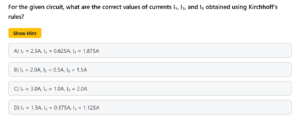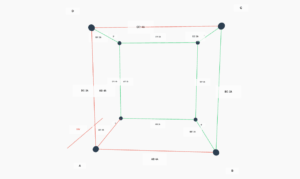Electron Drift Speed Simulation
This simulation demonstrates the drift speed of conduction electrons in a copper wire compared to thermal motion and electric field propagation. Adjust the current to see how it affects electron drift velocity.
Example
Question:
(a) Estimate the average drift speed of conduction electrons in a copper wire of cross-sectional area \(1.0 \times 10^{-7}\,\text{m}^2\) carrying a current of \(1.5\,\text{A}\). Assume that each copper atom contributes roughly one conduction electron. The density of copper is \(9.0 \times 10^3\,\text{kg/m}^3\), and its atomic mass is \(63.5\,\text{u}\).
(b) Compare the drift speed obtained above with, (i) thermal speeds of copper atoms at ordinary temperatures, (ii) speed of propagation of electric field along the conductor which causes the drift motion.
Solution:
(a) The direction of drift velocity of conduction electrons is opposite to the electric field direction, i.e., electrons drift in the direction of increasing potential. The drift velocity is
\[
v_d = \frac{I}{n e A}
\]
where \(e = 1.6 \times 10^{-19}\,\text{C},\, A = 1.0 \times 10^{-7}\,\text{m}^2,\, I = 1.5\,\text{A}\).
Density of copper is \(9.0 \times 10^3\,\text{kg/m}^3\) and atomic mass is \(63.5\,\text{g} = 63.5 \times 10^{-3}\,\text{kg}\). As \(6.0 \times 10^{23}\) copper atoms have a mass of \(63.5\,\text{g}\),
\[
n = \frac{6.0\times10^{23} \times 9.0 \times 10^6}{63.5}
= 8.5 \times 10^{28}\,\text{m}^{-3}
\]
Therefore,
\[
v_d = \frac{1.5}{8.5 \times 10^{28} \times 1.6 \times 10^{-19} \times 1.0 \times 10^{-7}}
= 1.1 \times 10^{-3}\,\text{m/s} = 1.1\,\text{mm/s}
\]
(b)
(i) At temperature \(T\), the thermal speed of a copper atom of mass \(M\) is typically of the order of \(\sqrt{k_B T/M}\), where \(k_B\) is Boltzmann constant. For copper at \(300\,\text{K}\), this is about \(2 \times 10^2\,\text{m/s}\). The drift speed of electrons is much smaller, about \(10^{-5}\) times the typical thermal speed at ordinary temperatures.
(ii) An electric field travelling along the conductor has the speed of an electromagnetic wave, equal to \(3.0 \times 10^8\,\text{m/s}\). The drift speed is extremely small in comparison; smaller by a factor of \(10^{-11}\).



